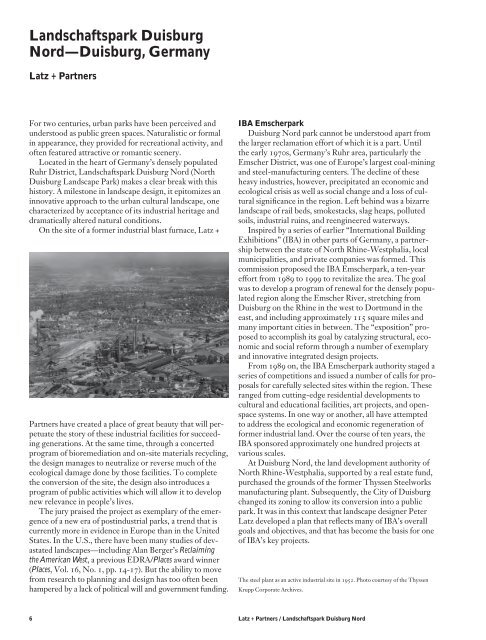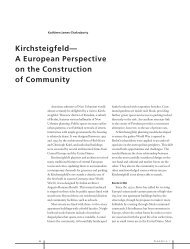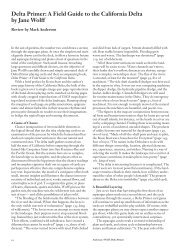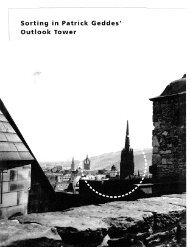Landschaftspark Duisburg Nord—Duisburg, Germany - Places
Landschaftspark Duisburg Nord—Duisburg, Germany - Places
Landschaftspark Duisburg Nord—Duisburg, Germany - Places
Create successful ePaper yourself
Turn your PDF publications into a flip-book with our unique Google optimized e-Paper software.
<strong>Landschaftspark</strong> <strong>Duisburg</strong><br />
Nord—<strong>Duisburg</strong>, <strong>Germany</strong><br />
Latz + Partners<br />
For two centuries, urban parks have been perceived and<br />
understood as public green spaces. Naturalistic or formal<br />
in appearance, they provided for recreational activity, and<br />
often featured attractive or romantic scenery.<br />
Located in the heart of <strong>Germany</strong>’s densely populated<br />
Ruhr District, <strong>Landschaftspark</strong> <strong>Duisburg</strong> Nord (North<br />
<strong>Duisburg</strong> Landscape Park) makes a clear break with this<br />
history. A milestone in landscape design, it epitomizes an<br />
innovative approach to the urban cultural landscape, one<br />
characterized by acceptance of its industrial heritage and<br />
dramatically altered natural conditions.<br />
On the site of a former industrial blast furnace, Latz +<br />
Partners have created a place of great beauty that will perpetuate<br />
the story of these industrial facilities for succeeding<br />
generations. At the same time, through a concerted<br />
program of bioremediation and on-site materials recycling,<br />
the design manages to neutralize or reverse much of the<br />
ecological damage done by those facilities. To complete<br />
the conversion of the site, the design also introduces a<br />
program of public activities which will allow it to develop<br />
new relevance in people’s lives.<br />
The jury praised the project as exemplary of the emergence<br />
of a new era of postindustrial parks, a trend that is<br />
currently more in evidence in Europe than in the United<br />
States. In the U.S., there have been many studies of devastated<br />
landscapes—including Alan Berger’s Reclaiming<br />
the American West, a previous EDRA/<strong>Places</strong> award winner<br />
(<strong>Places</strong>, Vol. 16, No. 1, pp. 14-17). But the ability to move<br />
from research to planning and design has too often been<br />
hampered by a lack of political will and government funding.<br />
6<br />
IBA Emscherpark<br />
<strong>Duisburg</strong> Nord park cannot be understood apart from<br />
the larger reclamation effort of which it is a part. Until<br />
the early 1970s, <strong>Germany</strong>’s Ruhr area, particularly the<br />
Emscher District, was one of Europe’s largest coal-mining<br />
and steel-manufacturing centers. The decline of these<br />
heavy industries, however, precipitated an economic and<br />
ecological crisis as well as social change and a loss of cultural<br />
signifi cance in the region. Left behind was a bizarre<br />
landscape of rail beds, smokestacks, slag heaps, polluted<br />
soils, industrial ruins, and reengineered waterways.<br />
Inspired by a series of earlier “International Building<br />
Exhibitions” (IBA) in other parts of <strong>Germany</strong>, a partnership<br />
between the state of North Rhine-Westphalia, local<br />
municipalities, and private companies was formed. This<br />
commission proposed the IBA Emscherpark, a ten-year<br />
effort from 1989 to 1999 to revitalize the area. The goal<br />
was to develop a program of renewal for the densely populated<br />
region along the Emscher River, stretching from<br />
<strong>Duisburg</strong> on the Rhine in the west to Dortmund in the<br />
east, and including approximately 115 square miles and<br />
many important cities in between. The “exposition” proposed<br />
to accomplish its goal by catalyzing structural, economic<br />
and social reform through a number of exemplary<br />
and innovative integrated design projects.<br />
From 1989 on, the IBA Emscherpark authority staged a<br />
series of competitions and issued a number of calls for proposals<br />
for carefully selected sites within the region. These<br />
ranged from cutting-edge residential developments to<br />
cultural and educational facilities, art projects, and openspace<br />
systems. In one way or another, all have attempted<br />
to address the ecological and economic regeneration of<br />
former industrial land. Over the course of ten years, the<br />
IBA sponsored approximately one hundred projects at<br />
various scales.<br />
At <strong>Duisburg</strong> Nord, the land development authority of<br />
North Rhine-Westphalia, supported by a real estate fund,<br />
purchased the grounds of the former Thyssen Steelworks<br />
manufacturing plant. Subsequently, the City of <strong>Duisburg</strong><br />
changed its zoning to allow its conversion into a public<br />
park. It was in this context that landscape designer Peter<br />
Latz developed a plan that refl ects many of IBA’s overall<br />
goals and objectives, and that has become the basis for one<br />
of IBA’s key projects.<br />
The steel plant as an active industrial site in 1952. Photo courtesy of the Thyssen<br />
Krupp Corporate Archives.<br />
Latz + Partners / <strong>Landschaftspark</strong> <strong>Duisburg</strong> Nord
Conceptual Considerations<br />
In a 2004 lecture, Latz explained some of the difficulties<br />
the site presents. “The park is not a park in the common<br />
sense, not easy to survey, not clearly arranged, not recognizable<br />
as a whole. According to its situation amidst chaotic<br />
agglomerations and infrastructure lines, it appears as a torn<br />
figure with numerous different aspects.” 1<br />
Nevertheless, when the idea for a park on the site of<br />
the former steel plant was born in 1989, he was struck<br />
by the power of its remnant patters of infrastructure and<br />
industrial relics—an aesthetic of gigantic objects that could<br />
potentially function as landmarks and nourish the genius<br />
loci of the site.<br />
The abandoned colossuses of steel production also<br />
spoke a language of the sublime. “A blast furnace is not<br />
only an old furnace. It is a menacing ‘dragon’ frightening<br />
men and rising above its surroundings,” Latz has said. 2<br />
In their groundbreaking concept, Latz + Partners<br />
2005 EDRA/<strong>Places</strong> Awards Design<br />
attempted to reveal the unique qualities of this place. Historic<br />
layers of use had left their physical marks through industrial<br />
imprints, altered conditions, and environmental contamination.<br />
However, the goal was to consider these disturbed<br />
and complex conditions for their creative potential rather<br />
than as a nuisance that should be erased or camouflaged.<br />
Based on thorough site survey and analysis, the designers<br />
were ultimately able to keep and reuse most of the<br />
existing industrial structures at <strong>Duisburg</strong> Nord. By transforming<br />
them in subtle and sensitive ways into parts of a<br />
new design, and by reprogramming their functions, they<br />
have successfully converted this former industrial site into<br />
a revolutionary new landscape type, one that is attracting<br />
more than 500,000 visitors per year.<br />
Overall plan of the new landscape park. Drawing courtesy of Latz + Partners.<br />
<strong>Places</strong> 17.3 7
Park Systems<br />
The 230-hectare (approximately 570-acre) project was<br />
developed in phases over the course of thirteen years,<br />
from 1989 to 2002. It consists of several layers of design<br />
elements that operate independently as park systems, and<br />
help create a sense of orientation that makes an extremely<br />
complex site interpretable at a human scale. Among<br />
major elements are a railroad park consisting of the raised<br />
ribbons of old rail-beds and other structures of a formerly<br />
manmade topography; new footbridges and promenades;<br />
a water park at its lowest level; and fi elds of vegetation—<br />
woodland-like groupings of trees, pioneer plants, and<br />
prairie meadows—situated between more linear elements.<br />
Many memorable places, all unique in character, are<br />
interwoven within this spatial framework: the Sinterpark<br />
and its large multifunctional plaza used for events; Secret<br />
Gardens hidden in former storage bunker structures; and a<br />
central Blast Furnace Park with elevated observation plat-<br />
8<br />
forms, climbing walls, rock gardens, and public spaces. The<br />
Piazza Metallica, situated at the symbolic heart of the park<br />
serves as its central event and gathering space. Here, a total<br />
of 49 recycled iron plates, each weighing seven to eight<br />
tons, were carefully arranged in a square, defi ning a plaza<br />
that is completely enclosed by looming industrial forms.<br />
With its unconventional appearance and unique new<br />
recreational opportunities, the park has become popular<br />
with local residents, making a great contribution to the<br />
surrounding lower-middle- and working-class neighborhoods<br />
on the north side of <strong>Duisburg</strong>. New activities range<br />
from hiking, biking, and exploring the park’s hidden<br />
corners, to social gatherings and large-scale cultural events.<br />
Much of the project’s charm results from the innovative<br />
reuse of individual site structures. For example, the<br />
park is home to the Gasometer, a former gas tank that has<br />
been fi lled with water and is now the world’s largest indoor<br />
diving center. Rugged concrete bunkers provide excellent<br />
Latz + Partners / <strong>Landschaftspark</strong> <strong>Duisburg</strong> Nord
training facilities for rock climbers. And landmarks such as<br />
smokestacks and old furnaces are illuminated at night with<br />
colorful spotlights that attract visitors.<br />
Restoring Ecological Awareness<br />
From the beginning, principles of ecology and sustainability<br />
guided the design and implementation of this<br />
new landscape. Remnants of demolished structures were<br />
reused in planting substrates, recycled concrete, or new<br />
paving materials.<br />
Creative ways were also found to treat runoff on site<br />
and integrate resulting new physical forms in the overall<br />
design. Most important has been the transformation of<br />
the Emscher River, which runs through the park from east<br />
to west. Previously, the river had served as an open sewer<br />
channel. The new design culverts and diverts wastewater,<br />
while converting the Emscher into a collector for pretreated<br />
runoff and rainwater.<br />
Significantly, Latz + Partners decided not to convert<br />
this reclaimed industrial channel into a pseudo-naturalistic,<br />
romantic, meandering waterway—as proposed by<br />
conservationists and other groups. Nevertheless, they<br />
managed to reestablish its ecological functioning as<br />
habitat for aquatic plants and wildlife. Platforms extending<br />
out over the water also make this new environment<br />
accessible to park visitors.<br />
In contrast to these highly designed interventions,<br />
other large areas of <strong>Landschaftspark</strong> <strong>Duisburg</strong> Nord were<br />
treated in ways primarily intended to reduce maintenance<br />
costs and keep energy inputs low. Disturbed soils on site<br />
2005 EDRA/<strong>Places</strong> Awards Design<br />
often have high concentrations of slag, cinder, and the<br />
remains of coal or coke. Such extreme biological conditions<br />
have resulted in “natural” vegetation growth that<br />
reflects the site’s industrial history. Moreover, over the<br />
years, seeds from all over the world were introduced along<br />
with industrial shipments, leading to a great present variety<br />
and mix of native and exotic species—as many as 450 neophytes.<br />
These plants now appear at many early stages of<br />
natural succession.<br />
Many publications have already referred to <strong>Landschaftspark</strong><br />
<strong>Duisburg</strong> Nord as one of the most intellectually rigorous<br />
and successful examples of postindustrial park design.<br />
Perhaps most significantly, it was featured in the 2005<br />
exhibition “Groundswell: Constructing the Contemporary<br />
Landscape” at the Museum of Modern Art in New York<br />
City. According to the exhibition catalogue, the project is<br />
“one of the most significant new parks of the last decade.” 3<br />
Without a doubt, this seminal work has expanded our<br />
definition of urban parks, and begun to influence the thinking<br />
of a new generation of landscape architects. Among<br />
its lessons are to be aware of the importance of thorough<br />
site analysis; to give equal weight to social and ecological<br />
considerations; to respect the genius loci; and, most importantly,<br />
to allow the form of a park to evolve from the past<br />
use of a site.<br />
— Judith Stilgenbauer<br />
Notes<br />
1. Peter Latz, “The Metamorphosis of the 20th Century’s Landscape,” March 1,<br />
2004, at the University of California, Berkeley.<br />
2. Ibid.<br />
3. Peter Reed, Groundswell: Constructing the Contemporary Landscape (New York:<br />
Museum of Modern Art, 2005). See also Lisa Diedrich, “No Politics, No Park: The<br />
<strong>Duisburg</strong>-Nord Model,” TOPOS, European Landscape Magazine 26 (March 1999);<br />
Niall Kirkwood, ed., Manufactured Sites, Rethinking the Post-Industrial Landscape<br />
(London: Spon, 2001); Arthur Lubow, “The Anti-Olmsted,” The New York Times<br />
Magazine, May 16, 2004; and Alan Tate, Great City Parks (London: Spon, 2001).<br />
Opposite Left: Cowper Place, a multifunctional plaza for events and gatherings.<br />
Photo by Christa Panick.<br />
Opposite Right: A big slide deposits children in a play area at the mouth of a<br />
former ore bunker. Photo courtesy of Latz + Partners.<br />
Top: The gardens of the Sinterpark occupy an area that once held a mix of fine-grain<br />
ore and other supplements used in the smelting process. Photo by Michael Latz.<br />
<strong>Places</strong> 17.3 9






